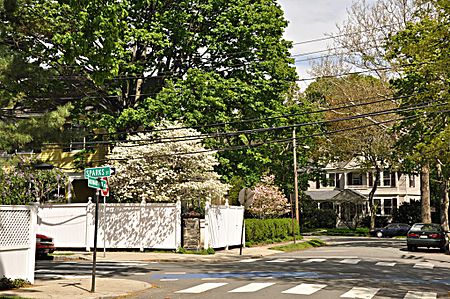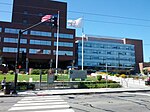Hubbard Park Historic District
Cambridge, Massachusetts Registered Historic Place stubsColonial Revival architecture in MassachusettsHistoric districts in Middlesex County, MassachusettsHistoric districts on the National Register of Historic Places in MassachusettsNRHP infobox with nocat ... and 2 more
National Register of Historic Places in Cambridge, MassachusettsQueen Anne architecture in Massachusetts

The Hubbard Park Historic District encompasses a residential development and park west of Harvard Square in Cambridge, Massachusetts. The area was originally the estate of Gardiner Hubbard, who had a 6-acre (2.4 ha) estate and house on nearby Brattle Street. In the 1880s Hubbard commissioned architects to build a ring of high quality homes around his mansion, which was demolished in 1939 and is now the site of Hubbard Park. The houses in this development are now located on Mercer Circle, Sparks Street, and Hubbard Park Road.The district was listed on the National Register of Historic Places (NRHP) in 1982.
Excerpt from the Wikipedia article Hubbard Park Historic District (License: CC BY-SA 3.0, Authors, Images).Hubbard Park Historic District
Hubbard Park Road, Cambridge
Geographical coordinates (GPS) Address Nearby Places Show on map
Geographical coordinates (GPS)
| Latitude | Longitude |
|---|---|
| N 42.376666666667 ° | E -71.131666666667 ° |
Address
Hubbard Park Road 12
02163 Cambridge
Massachusetts, United States
Open on Google Maps











